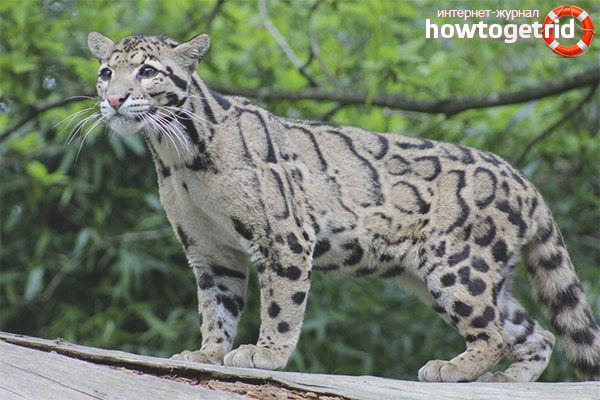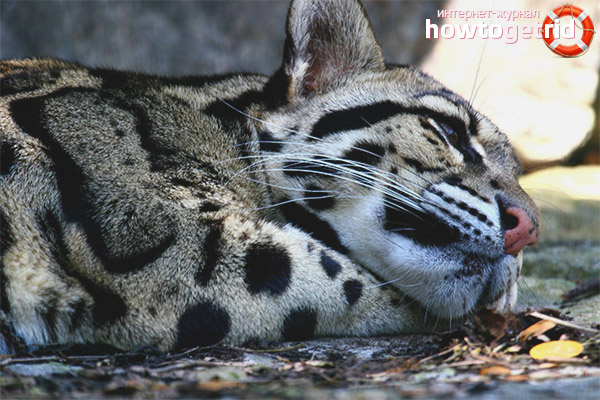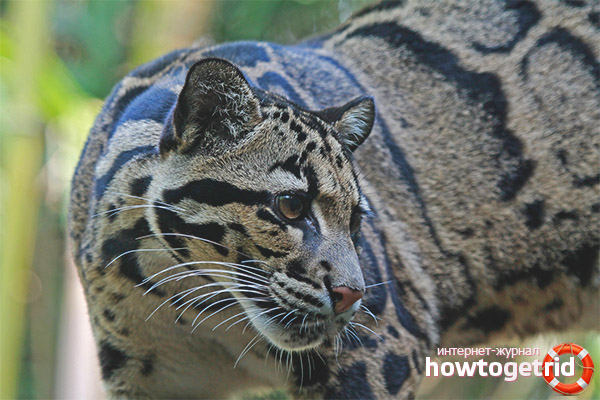The content of the article
Cats and representatives of the cat family have always been interesting to humans. These are very graceful, agile and fast animals with a wonderful unique color. Since a cat is considered a pet, this species can not be called endangered - as long as a person keeps cats at home, they will not be threatened with extinction. However, in natural feline conditions it is becoming smaller every year, some species are about to disappear. Smoky Leopard can be attributed to one of them.
Description
A smoky leopard does not apply to large or small cats - it occupies an intermediate position, combining the signs and characteristics of both. And in size it can be called rather an average cat.
The length of the animal (excluding the tail) is from about 85 to 105 centimeters. The height at the withers reaches half a meter. The fluffy tail is almost the entire length of the body and can reach 90-95 centimeters. The pride of the predator is covered with fur, forming a tassel at the end and decorated with black rings.
A leopard weighs about 20 kilograms, some larger individuals living in places where there are no nutritional problems gain 5-10 kilos more.
Smoky leopards, like a considerable number of mammals, have sexual dimorphism - the male is always larger than the female.
A distinctive feature of the smoky leopard is the special structure of the teeth, fangs protrude forward by almost 4 centimeters. For such a small animal, these are rather large teeth, therefore they often compare a smoky leopard with a saber-toothed tiger. The head of the animal, like all cats, is elongated, yellow eyes with oval vertical pupils are also feline, the nose is pinkish, sometimes with black spots.
Paws for an animal of this size are rather short, with the front legs slightly shorter than the rear. Large claws extend fully and hide deep into the limbs. When walking, a leopard touches the ground only with his fingers, and not with his entire foot.
Habitat
In the wild, a smoky leopard lives in tropical and subtropical forests of southeast Asian regions: in southern China, in Malacca, the habitat extends from the foothills of the Himalayas to Vietnam, many individuals live in Bhutan, Bangladesh and Thailand. Once there was even a separate subspecies in Taiwan - the Taiwanese smoky leopard, but, to the chagrin of many cat lovers, it has long died out.
In addition to dry forests, this animal is often found in marshy areas, but there he spends most of his time not on the ground, but prefers trees where it is drier and less biting parasites.
Behavior

Little is known about how leopards behave in their natural habitat. Most of the information obtained from observations of leopards in captivity. These animals can not be classified as day or night - they hunt at any time of the day, when it is more convenient for them. Although they like to do it more in the dark, knowing that many of their potential victims are sleeping. Moreover, the beast hunts not only on the ground, sneaking after the victim, tracking it, and then, with a rapid jerk, attacking the prey, but also on the trees. The physical characteristics and belonging to the cat genus allow leopards to live under the crowns of trees, on which they climb and climb perfectly.And they’re not just climbing, but they can do some kind of acrobatics on them - hanging on a branch, clinging with their paws, moving their heads down and so on. Trees, for the most part, are used as a resting place and shelter from land leeches living in Asian forests.
Each leopard has its own controlled area, in which he considers himself a complete host. As a rule, the area is 30-45 square kilometers, of which 4-5 are actively used.
Breeding
Not so much is known about the life of a smoky leopard in its natural habitat. All knowledge about this was obtained by observation in captivity. According to researchers, leopards are monogamous animals.
They become sexually mature at 25 to 30 months. But, unlike many animals, they are not so simple - for acquaintance and manifestation of feelings, cats need some time to talk, get used to each other, spend several weeks together. Experts say that otherwise, if the female does not like the male, he will bite her to death.
In the conditions of zoological gardens, the mating process takes place in the winter months - from the end of November to the beginning of March, however, under natural conditions, animals can mate at other time intervals throughout the year. Animals copulate over several days many times over. In this case, the male usually bites the female by the neck, and she announces the surroundings with a cry, making long moans. In nature, animals conduct the process of copulation in elevated hilly areas so that the sound spreads far.
After the mating process, the animals part, and the care of the offspring completely falls on the female shoulders.
Pregnancy lasts about three to three and a half months. In the second month, the stomach becomes noticeable, the nipples increase. When it comes time to give birth, the female climbs into the hollow of some tree, where the action takes place. The number of kittens born can be up to five, but usually the female gives birth to two cubs. They are born weighing up to 150 grams (depending on the number of births, the more - the easier the newborn is), the body already has large specks characteristic of the species. Only the spots are completely black and only at the age of six months they begin to lighten in the middle.
The mother carefully licks newborns, striving to ensure that the children are always clean. She continues to do this until the kittens learn to wash themselves.
Small leopards are born blind, their eyes open after 5-10 days, in the first three weeks of life their paws are weak, grow stronger on 20-21 days, and the children themselves begin to walk and run through the forest. And after six to seven weeks they are already able to climb trees with excitement.
Mother feeds her children milk for 10-12 weeks. Although already at 7-8 weeks he offers heirs meat and adult food, and they do not refuse. While the parent gets food for the offspring, they hide from enemies and dangerous animals in abundant forest thickets. Kittens live with their mother for a long time - up to ten months, gaining strength, growing up and learning adult skills and hunting. In the eleventh month, matured leopards begin to live an adult life and go in search and development of their own new territories.
Nutrition

Smoky leopard belongs to the breed of predators and feeds mainly on animal food. He catches monkeys on trees, catches and eats gaping birds with pleasure, since he knows how to balance on trees without much difficulty. With the victim caught, he deals with one blow of a powerful paw. On the ground he lies in wait and catches deer, goats, wild boars. Can catch and bully a buffalo. Having caught prey, he climbs onto a tree, settles on a high branch and cuts through the doomed animal's throat or breaks his back.
Being excellent swimmers, they catch and eat fish.
The leopard tries to stay away from human habitation, but if a person or element drives an animal to people, then the beast begins to hunt livestock, causing harm to humans.
Enemies
In addition, peasants are very dissatisfied with the fact that animals steal livestock and, in an attempt to protect their goods, wage war against forest thieves - set traps and traps, throw poisoned meat into the forest.
In natural conditions, animals are at war with other cats - tigers and panthers. They kill leopards, trying to eliminate competitors. That is why smoky leopards spend most of their lives on trees so as not to meet rivals.
Interesting
- Among the Asian peoples, the warrior who killed the leopard was considered a brave and courageous warrior. As a sign of special prowess, he wore the skin of a defeated beast.
- This type of leopard does not know how to roar loudly, scaring others. He, like a domestic cat, purrs softly and softly.
- On average, this species of leopards lives 11-12 years. In captivity, they survive to 17-8 years, but in nature - no more than 15.
- The animal is rather peculiar and although it is called a leopard, it has no direct relation to these animals. Smoky leopard is a rather ancient species, it is believed that it is the ancestral of all the current large cats that exist in nature.
- It is believed that cats are afraid of water. But this is not about smoky jaguars - they feel great in the water element and swim great. According to one version, on some islands (for example, Borneo), the ancestors of smoky leopards got by swimming.
Video: smoky leopard (Neofelis nebulosa)











Submit